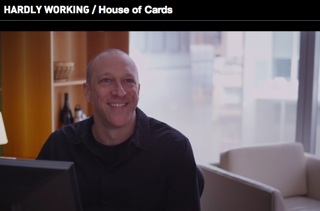 Paul Greenberg is CEO of CollegeHumor, a division of IAC that is growing faster than you can say Rodney Dangerfield. At this point, it is easy to believe that Greenberg’s mission for his organization, “To be the best and largest multimedia multi-platform comedy studio,” will be realized soon enough. In the meantime, I thought you would appreciate more insights from Paul on making viral videos, budgeting, how marketers can work with CollegeHumor and lastly, how to lead a creative organization.
Paul Greenberg is CEO of CollegeHumor, a division of IAC that is growing faster than you can say Rodney Dangerfield. At this point, it is easy to believe that Greenberg’s mission for his organization, “To be the best and largest multimedia multi-platform comedy studio,” will be realized soon enough. In the meantime, I thought you would appreciate more insights from Paul on making viral videos, budgeting, how marketers can work with CollegeHumor and lastly, how to lead a creative organization.
Drew: Is one type of video more likely to viral than another?
Often the ones that go really viral are new sketches. Because it is a new idea, it gets introduced, people latch onto it, they love it and they send it around. And so for example, we did one that was called, Gay Men Will Marry Your Girlfriends. The thrust is, let gay men marry each other because if not, they’re going to marry your girlfriends and they are going to be much better husbands than you would ever be!
Another one that went really viral was called Look At This Instagram (see below). And it wasn’t again in the Zeitgeist per se but it was a great take on how people use Instagram and it really kind of turned it on its head and parodied it beautifully and people just kind of I know I’ve seen those pictures a million times, I know what they are talking about, and so we really hit those.
Drew: Are series any different from a virality standpoint?
With series you are less apt to get into the Zeitgeist really quickly and so you build an audience over time. So we’ll often see in a series episodes further down the chain do better than the original ones or we’ll see them catch up. People will discover Very Mary Kate on its 10th episode and go ‘oh wow, I didn’t know about this, and I am going to go back and re-watch all of them. We see binge-watching all the time, people just come in and they watch fifteen videos at a time, and a lot of times it is going back to start series when they’ve come in the middle. Not that everything is serialized in terms of its plot, but it is just obviously thematically serialized and so we want to make sure that people love to go back and check it out.
Drew: So how do you budget for production?
We work a monthly basis. So, I say to the team, ‘here is your pot for the month, some you are going to spend more on some and less on some and you know do what you got to do.’ And we work very closely as a team to make sure that if, for example, we are going to go for broke on a Batman video, we are going to do a couple of more Hardly Workings or batch-shoot those and try to do things cheaply. Overall, we’re very efficient in terms of costs. We have figured out lots of ways to cut corners: we shoot in the office so we don’t have to pay location and we batch-shoot sometimes. It’s very efficient.
Drew: Are your videos the primary driver of traffic and new users?
To an extent, although sometimes the non-video content gets shared just as much as the video stuff. For example, the article Eight New Punctuation Marks That You Need got over a million views because it just got shared everywhere. And now there is interest in a series of it. So it really depends, [non-video] content can really drive a lot of view as well.
Drew: Do the video creative team also create the other stuff?
No. We have a separate production team including separate writers who have to be very topically driven.
Drew; Okay, do we get to the point where there is a cable station called CollegeHumor?
No, I don’t think so. I mean I feel like being the multiplatform studio that we are, we are as close to a new age cable channel as you can get.
Drew: So tell me about Coffee Town, your upcoming movie—did you write this in-house?
We actually did finance it but we didn’t write the script. Our agent UTA found Brad Copeland who was the writer for Arrested Development. Brad wrote his own movie script and was looking for somebody to help to allow him to produce it and direct it. So we were the studio. Brad wrote it, directed it and we produced it. We went out to LA and hired a film crew, a real legitimate movie crew, etc. (see trailer here)
Drew: I would suspect you are hoping to rally your army of CollegeHumor fans to see the movie, right?
Yeah, oh yeah. We’ll definitely use the army without question. A big part of this is the fact that we can mobilize 20 million people immediately to say or to at least raise awareness if not to get them off their butts into the theatres. And if we put it on iTunes, we can say, hey click here and you’ll be able to watch CollegeHumor’s movie.
Drew: What exactly is native advertising and what are you doing in this area?
Native advertising is when the advertising blends more with existing content and it becomes less distinguishable as an ad. We’ve been doing that for five years whether we called it branded entertainment or branded content or branded advertising or native advertising, About a year ago, we reorganized an entire group around native advertising. We hired two comedy writers just to write branded content and native advertising pieces and we also reorganized a production team so now we have a native advertising production team that just creates videos for advertisers. Out of those 50 videos we create in a month, maybe less than half are advertising video. But it still feels like CollegeHumor content and people — advertisers [like KFC, AXE & Listerine] come to us because they are interested in our sensibility.
Drew Neisser: What’s the best way for marketers to work with CollegeHumor?
Great question. We need to understand what you are trying to do. Are you trying to increase sales? Are you trying to just increase your brand perception? Are you trying to increase relevancy? Are you trying to activate an audience to go do something? Is about getting more Facebook likes? What do you want as a brand? And then we can help you come up with content that fits that goal.
Drew: How involved are you in the content decision making process?
Not that involved, at this point, certainly not day to day. We have a phenomenal team of very creative people who are very good at what they do. I get involved at a high level making sure that we have a strategy and we are trying to follow it and everybody knows what that strategy. I’ll get very involved if something is questionable from a legal perspective or a taste perspective. But on balance, and that’s how I try to manage my team – hire the best people you can, hopefully people who are smarter than you, and who are experts at what they do and you get obstacles out of their way and you let them do what they do. And so I don’t see any need to micromanage the content team. Besides, I’m not that funny.
Drew: Have you gotten funnier since you joined?
Much. Much funnier–I’m hilarious. Actually it is intimidating in a way because these guys are really funny. And they are so quick. We have our weekly staff meetings and even a lot of the executives are standups [comics], and they are just hilarious. I mean it is like somebody took all of the best class clowns and put them all together in one room, it’s hysterical. It is a really fun place to work.
Drew Neisser: Do you ever say to yourself, ‘I can believe I have this job?’
Yeah. Yeah, it’s awesome. I love creating content and creating products that affect people’s lives in a positive way. That’s one of the things that’s always driven me from a business perspective.
Drew: How about a few secrets to your success?
One is, never stop working ever; just be as aggressive as possible and want to win and do your work your absolute hardest because there is always somebody who is going to work harder than you are and ideas are wonderful but they are a dime-a-dozen. Everything comes down to execution and doing it right and doing it well.
Drew: Do you have any advice for new or aspiring CEOs?
The advice somebody once gave me for managing is, only do what only you can do and spend your time doing that. To that end, I wrote an article on this recently that identified five things that CEOs should spend their time doing:
- Set the strategy for what the company needs to be and what we are trying to accomplish and what’s our mission and where are we going. And that’s not done in a vacuum per se, that’s done with the team but ultimately the leader has to be the one who puts his or her stamp on it and say this is the direction we are going to go.
- Then it’s making sure that the strategy is communicated very well and that everybody knows what’s going on and that there’s absolutely no misunderstanding. And making sure that everybody is coordinated so that ad sales and editorial and marketing and PR all know what each of the other ones is doing, to help support that overall strategy.
- Then its hiring and firing. Personnel. Putting the right people in place, and making sure that they are — smarter than you, they’re experts in their field and they are great.
- Then it is getting obstacles out of their way and letting them do their jobs and not micromanaging them but making sure that if there is something wrong, that you are there to help them.
- The fifth thing is making sure there’s enough capital to run the business and making sure there is a business plan that can be executed.
Drew: You’ve been on both sides of the creative development process including being a voice over talent and a radio announcer. Do you think that has helped you as a leader of a creative-driven company?
Yes. If there is somebody who is never been a creative before and never been on the talent side, you’re going to make decisions purely based on the bottom-line and probably potentially the wrong ones.
Note: this is the 2nd part of my interview with Paul. Click here to see the first part.
